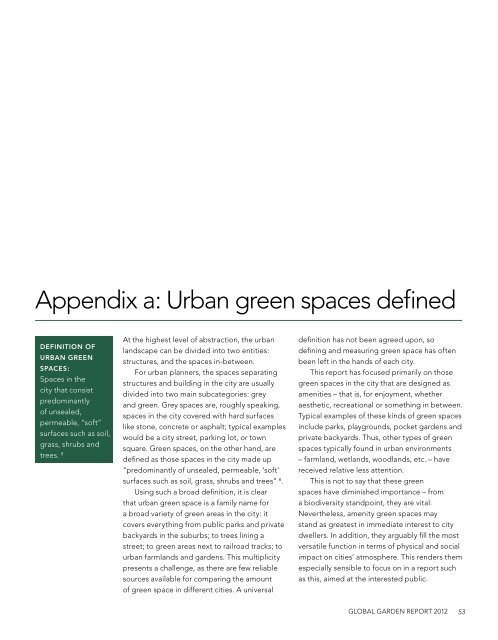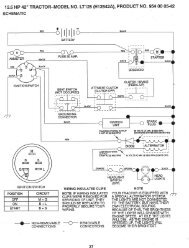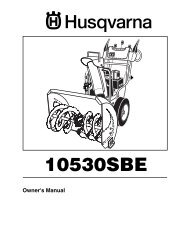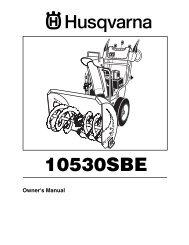GLOBAL GARDEN REPORT 2012 - Husqvarna Group
GLOBAL GARDEN REPORT 2012 - Husqvarna Group
GLOBAL GARDEN REPORT 2012 - Husqvarna Group
You also want an ePaper? Increase the reach of your titles
YUMPU automatically turns print PDFs into web optimized ePapers that Google loves.
Appendix a: Urban green spaces defined<br />
DEFINITION OF<br />
URBAN GREEN<br />
SPACES:<br />
Spaces in the<br />
city that consist<br />
predominantly<br />
of unsealed,<br />
permeable, “soft”<br />
surfaces such as soil,<br />
grass, shrubs and<br />
trees. 8<br />
At the highest level of abstraction, the urban<br />
landscape can be divided into two entities:<br />
structures, and the spaces in-between.<br />
For urban planners, the spaces separating<br />
structures and building in the city are usually<br />
divided into two main subcategories: grey<br />
and green. Grey spaces are, roughly speaking,<br />
spaces in the city covered with hard surfaces<br />
like stone, concrete or asphalt; typical examples<br />
would be a city street, parking lot, or town<br />
square. Green spaces, on the other hand, are<br />
defined as those spaces in the city made up<br />
“predominantly of unsealed, permeable, ‘soft’<br />
surfaces such as soil, grass, shrubs and trees” 8 .<br />
Using such a broad definition, it is clear<br />
that urban green space is a family name for<br />
a broad variety of green areas in the city: it<br />
covers everything from public parks and private<br />
backyards in the suburbs; to trees lining a<br />
street; to green areas next to railroad tracks; to<br />
urban farmlands and gardens. This multiplicity<br />
presents a challenge, as there are few reliable<br />
sources available for comparing the amount<br />
of green space in different cities. A universal<br />
definition has not been agreed upon, so<br />
defining and measuring green space has often<br />
been left in the hands of each city.<br />
This report has focused primarily on those<br />
green spaces in the city that are designed as<br />
amenities – that is, for enjoyment, whether<br />
aesthetic, recreational or something in between.<br />
Typical examples of these kinds of green spaces<br />
include parks, playgrounds, pocket gardens and<br />
private backyards. Thus, other types of green<br />
spaces typically found in urban environments<br />
– farmland, wetlands, woodlands, etc. – have<br />
received relative less attention.<br />
This is not to say that these green<br />
spaces have diminished importance – from<br />
a biodiversity standpoint, they are vital.<br />
Nevertheless, amenity green spaces may<br />
stand as greatest in immediate interest to city<br />
dwellers. In addition, they arguably fill the most<br />
versatile function in terms of physical and social<br />
impact on cities’ atmosphere. This renders them<br />
especially sensible to focus on in a report such<br />
as this, aimed at the interested public.<br />
<strong>GLOBAL</strong> <strong>GARDEN</strong> <strong>REPORT</strong> <strong>2012</strong><br />
53

















